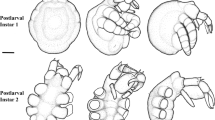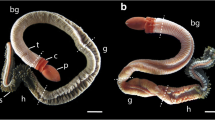Abstract
In this paper, new data on larval and postlarval stages after newly collected and museum-deposited material of six Ammothea species is provided and compared with previously known information. Different developmental stages attached to the ovigerous legs of adult males for each species were found: four stages [protonymphon (Ptn), postlarval instar 1 (PL-1), postlarval instar 2 (PL-2), and postlarval instar 3 (PL-3)] for A. carolinensis; just one (Ptn) for A. clausi and A. minor; three stages (Ptn, PL-1, PL-2) for A. bicorniculata and A. spinosa; and other three (Ptn, PL-2, PL-3) for A. longispina. In the present contribution, the external morphology of each larval and postlarval instar is described, illustrated, and discussed. The larval and postlarval development of Ammothea bicorniculata, A. carolinensis, A. longispina, and A. spinosa is characterized by (1) the eggs hatch as a protonymphon larva; (2) the larvae and subsequent postlarval stages have yolk reserves and a relatively large size (0.5–0.85 mm in length for the protonymphon); (3) the postlarvae remain on the ovigerous legs of males during several moults; (4) the spinning spine is absent; and (5) the development of walking legs is sequential. The protonymphon larva of A. clausi and A. minor is the only stage on the ovigerous legs of males, and this stage is characterized by: (1) there is no yolk reserve and it has a relatively small size (0.22–0.3 mm in length); (2) the spinning spine is present; and (3) all larval appendages have a relatively large size.



















Similar content being viewed by others
References
Arnaud F, Bamber R (1987) The biology of Pycnogonida. Adv Mar Biol 24:1–96
Bain BA (2003a) Postembryonic development in the pycnogonid Austropallene cornigera (Family Callipallenidae). Invertebr Reprod Dev 43:181–192
Bain BA (2003b) Larval types and a summary of postembryonic development within the pycnogonids. Invertebr Reprod Dev 43:193–222
Bain BA, Govedich FG (2004) Courtship and mating behavior in the Pycnogonida (Chelicerata: Class Pycnogonida): a summary. Invertebr Reprod Dev 43:63–79
Bamber RN (2007) A holistic re-interpretation of the phylogeny of the Pycnogonida Latreille, 1810 (Arthropoda). Zootaxa 1668:295–312
Behrens W (1984) Larvenentwicklung und Metamorphose von Pycnogonum litorale (Chelicerata, Pantopoda). Zoomorphology 104:266–279
Bogomolova EV (2007) Larvae of three sea spider species of the Genus Nymphon (Arthropoda: Pycnogonida) from the White Sea. Russ J Mar Biol 33:145–160
Bogomolova EV, Malakhov VV (2003) Larvae of sea spiders (Arthropoda, Pycnogonida) of the White Sea. Entomol Rev 83:213–227
Bogomolova EV, Malakhov VV (2004) Fine morphology of sea spider larvae (Arthropoda, Pycnogonida) of the White Sea. Zool Bespozvon 1:3–28
Bogomolova EV, Malakhov VV (2006) Lecithotrophic protonymphon is a special type of postembryonic development of sea spiders (Arthropoda, Pycnogonida). Dokl Biol Sci 409:328–331
Bouvier EL (1913) Pycnogonides du pourquoi Pas? In: Calman WT (ed) Deuxième Expédition Antarctique française (1908–1910) 6. Masson, Paris, pp 1–169
Brenneis G, Arango CP, Scholtz G (2011) Morphogenesis of Pseudopallene sp. (Pycnogonida, Callipallenidae) I: embryonic development. Dev Genes Evol 221:309–328
Burris ZP (2011) Larval morphologies and potential developmental modes of eight sea spider species (Arthropoda: Pycnogonida) from the southern Oregon coast. J Mar Biol Assoc UK 91:845–855
Calman WT (1915) Pycnogonida. British Antarctic (Terra Nova) Expedition, 1910. Zool 3:1–74
Cano E, López-González PJ (2009) Novel mode of postembryonic development in Ammothea genus (Pycnogonida: Ammotheidae) from Antarctic waters. Sci Mar 73:541–550
Cano E, López-González PJ (2010) Postembryonic development of Nymphon unguiculatum Hodgson 1915 (Pycnogonida, Nymphonidae) from the South Shetland Islands (Antarctica). Polar Biol 33:1205–1214
Child CA (1995) Antarctic and Subantarctic Pycnogonida 1. The Family Ammotheidae. In: Cairns SD (ed) Biology of the Antarctic Seas XXIII. Antarct Res Ser 63:1–48
Dogiel V (1913) Embryologische Studien an Pantopoden. Z Wiss Zool Abt A 107:575–741
Ferrari FD, Fornshell JA, Vagelli AA, Ivanenko VN, Dahms HU (2011) Early postembryonic development of marine chelicerates and crustaceans with a nauplius. Crustaceana 84:869–893
Fornshell JA, Ferrari FD (2012) Larvae of the pycnogonids Ammothea gigantea Gordon, 1932 and Achelia cuneatis Child, 1999 described from archived specimens. Arthropod 1:121–128
Fry WG, Hedgpeth JW (1969) Pycnogonida, 1. Colossendeidae, Pycnogonidae, Endeidae, Ammotheidae. Fauna of the Ross Sea, 7. Mem N Z Oceanogr Inst 49:1–139
Gillespie JM, Bain BA (2006) Postembryonic development of Tanystylum bealensis (Pycnogonida, Ammotheidae) from Barkley Sound, British Columbia, Canada. J Morphol 267:308–317
Gordon I (1932) Pycnogonida. Discov Rep 6:1–138
Gordon I (1944) Pycnogonida. Rep B A N Z Antarct Res Exped 5:1–172
Gutt J (2008) The Expedition ANTARKTIS-XXIII/8 of the Research Vessell “Polarstern” in 2006/2007. Ber Polarforsch Meeresforsch 569:1–153
Hedgpeth JW (1947) On the evolutionary significance of the Pycnogonida. Smithsonian Misc Collect 106:1–54
Hodgson TV (1927) Die Pycnogoniden der Deutschen Südpolar-Expedition 1901–1903. Dtsch Südpolar Exped Ser II Zool 19:303–358
Lou TH (1936) Notes sur Lecythorhynchus hilgendorfi Böhm (Pycnogonida). Contributions from the Institute of Zoology. Natl Acad Peiping 3:133–163
Lovely EC (2005) The life history of Phoxichilidium tubulariae (Pycnogonida; Phoxichilidiidae). Northeast Nat 12:77–92
Nakamura K (1981) Post-embryonic development of a pycnogonid, Propallene longiceps. J Nat Hist 15:49–62
Ohshima H (1933) Young pycnogonids found parasitic on nudibranchs. Annot Zool Jap 14:61–66
Okuda S (1940) Metamorphosis of a pycnogonid parasitic in a hydromedusa. J Fac Sci Hokkaido Univ (ser 6 Zool) 7:73–86
Russel DJ, Postscript: Hedgpeth JW (1990) Host utilization during ontogeny by two pycnogonid species (Tanystylum duospinum and Ammothea hilgendorfi) parasitic on the hydroid Eucopella everta (Coelenterata: Campanulariidae). Bijdr Dierkd 60:215–224
Staples DA, Watson JE (1987) Associations between pycnogonids and hydroids. In: Bouillion J (ed) Modern trends in the systematics, ecology and evolution of hydroids and hydromedusa. Oxford University Press, Oxford, pp 215–226
Stiboy-Risch C (1992) Ammothea bicorniculata, eine neue Art der Ammotheidae aus der Antarktis (Pantopoda, Pycnogonida). Bonn Zool Beitr 43:333–338
Vilpoux K, Waloszek D (2003) Larval development and morphogenesis of the sea spider Pycnogonum litorale (Ström, 1762) and the tagmosis of the body of Pantopoda. Arthropod Struct Dev 32:349–383
Wilhelm E, Bückmann D, Tomaschko KH (1997) Life cycle and population dynamics of Pycnogonum litorale (Pycnogonida) in a natural habitat. Mar Biol 129:601–606
Acknowledgments
The authors would like to express their gratitude to Miranda Lowe (British Museum of Natural History) for her extensive search for BANZARE specimens in the collections of the BMNH, especially for the loan of the male of Ammothea spinosa bearing the larvae here described and illustrated. Our thanks are also addressed to the officers and crew and many colleagues for their help on board during the Polarstern ANT XXIII/8 cruises. We take this opportunity to extend our thanks to the cruise leader and steering committee of the cruise, especially Julian Gutt and Enrique Isla (ANT XIII/8), all of whom kindly facilitated the work on board and allowed us to collaborate in this Antarctic programme. We thank the Editor and referees by their useful suggestions and criticisms that substantially improved this work. Support for this work was partially provided by POL2006-06399/CGL (Polarstern ANT XXIII/8 - CLIMANT). Mr. Tony Krupa is thanked for reviewing the English version.
Author information
Authors and Affiliations
Corresponding author
Rights and permissions
About this article
Cite this article
Cano Sánchez, E., López-González, P.J. New data concerning postembryonic development in Antarctic Ammothea species (Pycnogonida: Ammotheidae). Polar Biol 36, 1175–1193 (2013). https://doi.org/10.1007/s00300-013-1338-0
Received:
Revised:
Accepted:
Published:
Issue Date:
DOI: https://doi.org/10.1007/s00300-013-1338-0




